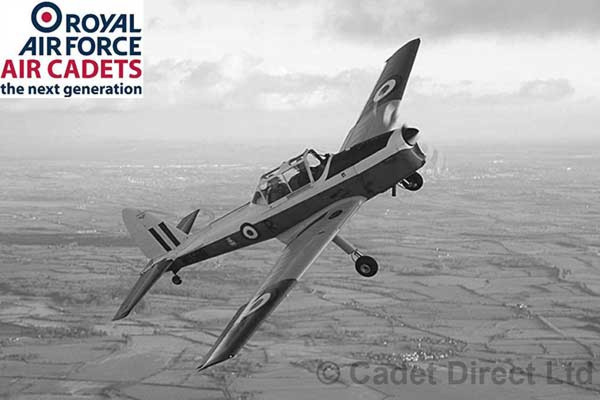RAF Air Cadets - The History Behind the ATC
THE HISTORY OF THE AIR TRAINING CORPS
Like many youth organisations in the UK the early formation of the Air Training Corps (ATC) was through the efforts of a few dedicated people, who could see the need to give young people the opportunity to experience the thrills of flying.
In late 1918 two men, one an ex Royal Flying Corps Flying Cadet Charlie Longman and the other an ex Air Mechanic Bob Weller both founded the Bournemouth Young Airmen’s League. They were fortunate to have support of the then established Air League of the British Empire.
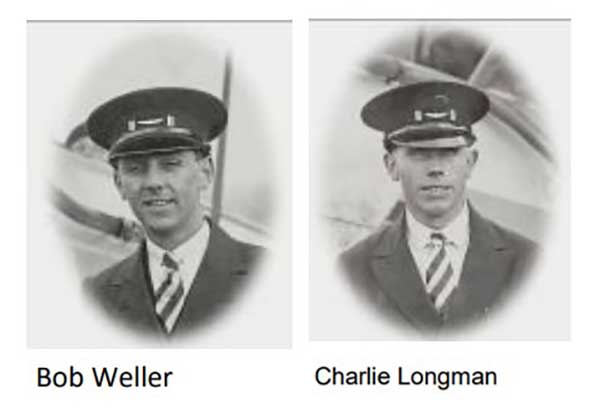
Founding members of the Bournemouth Young Airmen's League
In 1929 it was decided to form a British Young Airmen’s League and the aims of this were set out to create a national interest in aviation and to spread the gospel of “Airmindedness” among the younger generation.
The object of each squadron would be to imitate and practice the general routine of a civil aerodrome and the work carried out by squadrons of the Royal Air Force.
The members of each squadron to be classified so as to undertake various duties. By so doing each member would develop a feeling of importance and responsibility, and each squadron would become a useful unit.
Where possible gliding should be included. Members could be granted a distinguishing badge after passing certain "tests”.
It was not until 1938 when the threat of an impending war was becoming more of a certainty, that the Air Defence Cadet Corps (ADCC) was formed under the guidance of the Air League of the British Empire.
The first squadron was formed at Leicester in July 1938.
The aim of the training was to “Train youths in all matters connected with aviation” and boys between 14 and 18 were allowed to join.
A squadron consisted of 100 boys, divided into flights of 25 and by the end of that year, only five months after, forty one new squadrons had been formed.
During 1939 more than 16,800 boys and 700 officers were members of the ADCC. The General Secretary of the ADCC was Air Commodore Chamier who devised the Motto “Venture Adventure” which we still use today.
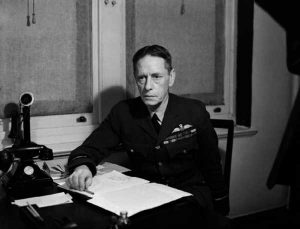
Air Commodore Chamier
The obvious advantage of having young men who had received some initial training in “all matters connected with aviation” was welcomed by the Royal Air Force and as a result a close working relationship developed. Some of the more lucky cadets whose units were close to RAF stations carried out the first glider training.
By 1940 the ADCC was making such a contribution to the recruitment for the RAF that it was decided by the War Cabinet to establish an organisation on the widest basis to provide pre-entry training for candidates for aircrew and technical duties for both the RAF and the Fleet Air Arm.
FORMATION OF THE ATC
As a result of this, the Air Training Corp was established. In September 1940 there were 18,489 Cadets in the ADCC.
Throughout the war years the Air Training Corps became one of the most important pre-service training organisations providing the RAF with recruits who were “airminded” when they enlisted.
It was not an easy task for the many volunteer officers and instructors, who were all employed in their various jobs of “war work” during the day or night and then, as they do today, spend their spare time in training their cadets.
The Tiger Moth 7 as illustrated below was familiar to cadets from the earliest days until replaced by the Chipmunk.
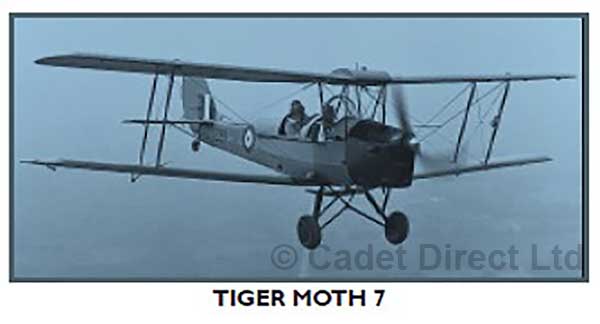
Tiger Moth 7 in flight
In the post war years there was a need to change the direction of the training and in 1947 by Royal Warrant the aims of the ATC were changed to include training in Citizenship, the promotion of sport and adventure activities.
In the same year exchange visits were started with Canadian cadets. Four lucky cadets accompanied the Royal Tour to South Africa.
1948 a major policy change was made to improve Glider Training by the introduction of the 2 seater Slingsby T21B called the Sedbergh enabling Cadets to receive instruction when flying.
1949 due to the fact that many cadets wanted to fly, The Flying Scholarship was introduced taking 250 Cadets a year and training them to the standard of Private Pilot licence.
Throughout the following ten years a great deal of reorganisation of the training and administration took place. As a result of this it established the future role of the Air Training Corps and many new ATC Wings were formed.
The Territorial Army Volunteer Associations (now named Reserve Forces & Cadet Association) across the country took over the responsibility for the provision and maintenance of those ATC buildings not on RAF stations.
In 1953 His Royal Highness Prince Philip, the Duke of Edinburgh became the Air Commodore in Chief. During this same year the new Training Syllabus was introduced.
In 1955 it was proposed that control and administration of the ATC would be passed from Home Command to a Commandant directly responsible to the Air Ministry.
It was also proposed that there should be a revision of training methods, the issue of battledress for cadets and better facilities for Air Experience Flights.
During 1957 the ATC were the first to have cadets awarded the Duke of Edinburgh Award Gold and Silver Awards. By 1957 in the same year it was decided that the corps would have its own fleet of 50 Chipmunk aircraft, established in 13 Air Experience Flights located at existing University Air Squadrons. In February 1959 the rank of Cadet Warrant Officer was introduced
Chipmunk in flight
The year 1958 was of special note as it saw the formation of Air
Experience Flights with a fleet of 50 Chipmunk aircraft. At this time there were 27 Gliding Schools and 2 Gliding centres in existence.
In 1959 Flying Training Command took responsibility for the ATC, and in May 1960 the Headquarters Air Cadets was set up at White Waltham as a separate formation for organisation and direction of the ATC.
In the ten years 1951 to 1961 over 58,000 cadet entered the RAF, nearly 33,000 on Regular Engagements.
The new Training Syllabus was introduced in 1961.
In 1962 The ATC celebrated 21 years of “Venture Adventure” Prince
Philip, Duke of Edinburgh presented his Banner to the ATC at a ceremony held in the Royal Air Force Chapel, St Clement Danes Church, Holborn, London.
By 1963 the International air cadet exchange had grown to such an extent that it included the United Kingdom, Canada, Israel, Spain, Portugal, Greece, Turkey, Italy, France, Holland, Belgium, West Germany, Norway, Sweden, Denmark, Switzerland, Austria and Finland.
During the Easter and Summer Camp periods of 1964, ATC cadets went to RAF Stations in Germany for the first time.
ADVENTURE TRAINING INTRODUCED
1965 Adventure Training was officially recognised in 1965 as part of the training syllabus was carried out at the newly opened ATC Adventure Training Centre at Windermere in the Lake District.
Also in 1965, ATC cadets took part in the Nijmegen March in Holland.
In 1967 a Review Committee - The Morris Committee - looked at the organisation of the ATC. They made many recommendations; creating ATC Regions to be controlled by Regional Commandants. Wings were redefined to comprise 20 squadrons.
The age of enrolment was lowered to 13 years 9 months.
Additional places were established to enable recruiting of more officers and instructors.
The year 1968 saw the formation of 6 further Regions alongside the
existing Scottish Region.
The Headquarters Air Cadets moved from RAF White Waltham to RAF Station Brampton in Cambridgeshire.
In April 1969 seven Regional Commanders assumed control and command of their new Regions.
The Air Training Corps newspaper the Air Cadet News was established as a monthly newspaper.
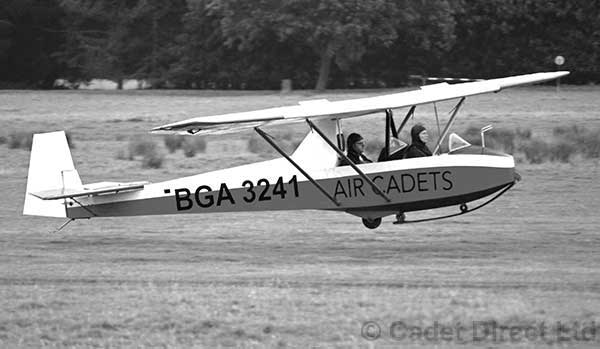
Cadet Mk 3 Glider, provided by Stephan Kopelke
1970 saw the first Inter Service Cadet Swimming Championship, between the Army Cadet Force, Sea Cadet Corps and the Air Training Corps. In this year trials were started with the SLG (Self Launching Glider) fitted with an engine which was switched off on gaining the correct height.
1971 was the 30th birthday of the ATC, and in 1972 Air Navigation was introduced as an ‘O’ Level subject. The first ATC camps to be held in Malta were in 1973, they continued until Malta gained its independence and a change in the political climate in 1978.
1975 saw Headquarters Air Cadet on the move again and were established at RAF Station Newton in Nottinghamshire.
1976 Gibraltar was an Annual Camp venue for the first time.
1977 was the Queens Silver Jubilee Review of the Reserve Forces held at RAF Station, Finningley, South Yorkshire. The ATC took part in the Review and also put on a display for the occasion. The Venture motor glider entered service at selected air cadet volunteer gliding schools.
In 1979 HRH The Duke of Edinburgh presented a new Banner to the ATC. In this year the first ATC camps were held in Cyprus.
[caption id="attachment_7203" align="alignnone" width="600"]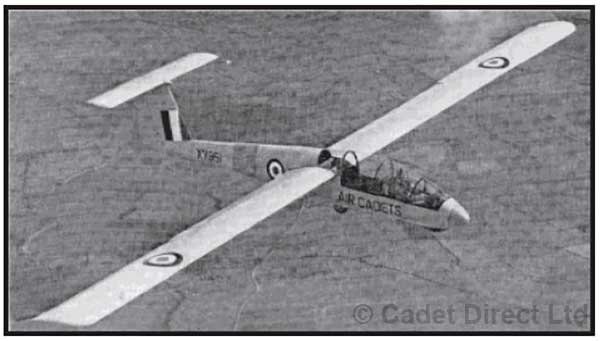 Leading Cadet Stitt was the first cadet to fly solo the Slingsby T-53B on 15th August 1968.[/caption]
Leading Cadet Stitt was the first cadet to fly solo the Slingsby T-53B on 15th August 1968.[/caption]
Leading Cadet Stitt was the first cadet to fly solo the
Slingsby T-53B on 15th August 1968.
POLICY CHANGE - GIRLS JOIN ATC
1980 saw a welcome change in recruiting policy when a scheme was
introduced for girls to join the ATC.
The first award of the Darce Sword was made to the Best Cadet in the Corps.
Meteorology was introduced as an ‘O’ level subject.
1981 girl cadets were flying solo in gliders, gaining marksmanship badges and taking an active part in the DofE Award Scheme
1981 4th Feb was the 40th Anniversary of the ATC, HRH The Duke of Edinburgh, Air Commodore in Chief, presented a special award to the Corps to be known as the “Guinea Pig Prize” to be awarded in recognition of an outstanding individual performance. Girls cadets joined 22 selected squadrons throughout the Corps. Cadet Fiona Brown No.404 (Brough of Morpeth) Squadron being the first girl Cadet in the Corps to gain a Gold Award.
In 1982 following the success of the initial stages of the trial, the scheme for girls in the ATC was extended to one Squadron in each wing. Proposals are put to the Air Council for the extension of the scheme. The first woman to command an ATC Squadron No 2500 (St Neots) was Flight Lieutenant Janet Page WRAF(T). FS James Smith of No 356 (Felixstowe) Squadron was the first recipient of the Kriegie Trophy as the best ATC cadet to attend Frimley Park Leadership Course.
In the same year, The Air Gunners Association presented the Corps with a trophy to be competed for in the pre-Bisley competition shoot. RAF Station Wethersfield was the first USAF base to host a voluntary gliding school. Flight Sergeant Simon Burrows of No 127 (Wakefield) Sqn and Cadet Daniel Norman of No 1013 Sqn (Quantock) Sqn were awarded the Guinea Pig Prize who rescued a friend from the sea.
In 1982 FS Anthony Hambleton, the 1982 Dacre Sword winner was the first Air Cadet to fly in a tornado aircraft of TWCU at RAF Honington. On 20th September the ASK 21 and ASW 19 Gliders came into service with the Air Cadet Gliding Organisation at ACCGS RAF Syerston.
Ten Vanguards (dual seat) joined the fleet as well as five Valiants (single seat) and two Janus Cs (dual seat).During 1983 Air Cadet gliders took part in the National Championships at Lasham and Husbands Bosworth and at the Inter - Services Championships at Henlow.
1982 approval was given to replace the Sedbergh and Kirby Cadet
Gliders and replace them with the ASK 21 Vanguard a tandem 2 seater high performance glider and the ASW 19 (Valiant) a single seater.
In 1984 the first award of the Dacre Brooch is made to a CWO Fiona
Brown No 404 (Morpeth) Squadron by Mrs Dacre at a ceremony at Newcastle Airport. The Diamond Brooch is mounted on a blue sash bordered by gold braid. Below the brooch is the Corps motto. “Venture Adventure”.
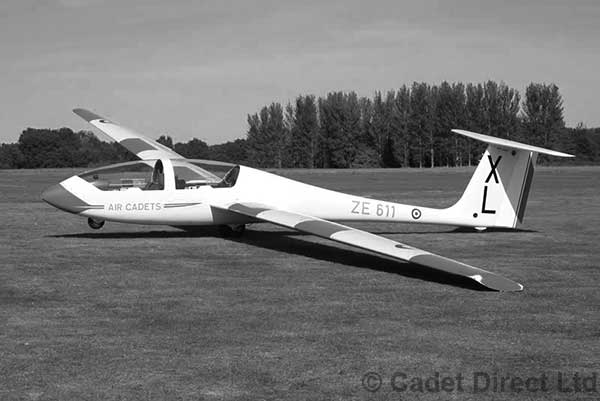
Viking (Grob G103 Twin 11) glider
NEW GLIDER FOR ATC
On the 5th October at ACCGS, Lord Trefgarne, Under Secretary of State for the Armed Services, brought the Viking (Grob G103 Twin 11) glider into service.
Viking T Mk 1 The Grob 103 Viking entered service in 1984. They were the first of 100 new dual seat gliders to replace the Slingsby wooden gliders (12B and T31), delivered during 1984/5.
In May 1985 Her Majesty The Queen as Patron, presented the Royal Aero Club Diploma to the ATC. The award was made for:
“exceptional service in providing flying and gliding training
and associated aviation skills to cadets 1941 to 1985".
Two cadets from Cyprus No1(Akrotiri) Squadron were the first cadets to undertake a glider proficiency course on Venture gliders at ACCGS Syerston.
In 1986 the first Save and Prosper Scholarships were awarded to five cadets. The cadets spent a two weeks course at the RAF Gliding and Soaring Association at RAF Bicester.
The Gill Trophy was presented to No 2390 (Belfast Royal Academy)
Squadron by Mrs Irene Gill, widow of the late Honorary Secretary of the Air Gunners Association at the Inter Service Cadet Rifle Meeting at Bisley in 1986 for the best aggregate score.
A new Adventure Training Centre was announced at Llanbedr, near Harlech, North Wales to be opened in the Spring of 1988.
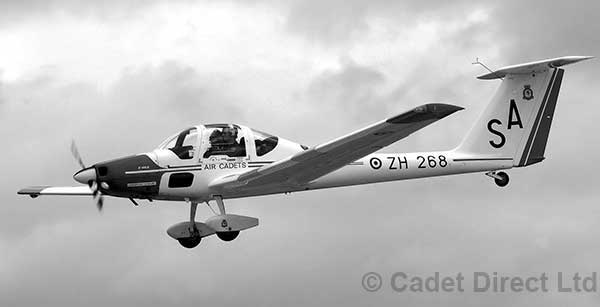
The Vigilant Grob G109
FACTS
From 1983 to 1986 inclusive Air cadets provided some 26% of the annual RAF intake of officers, airmen and apprentices. In 1987, 76% of Direct Entry Pilots joining the Royal Air Force were ex-members of the Air Training Corps or Combined Cadet Force (RAF Sections).
1987 From the 1st January cadets could be enrolled into the Corps at the minimum age of 13 years and 3 months.
1990 On the 1st March The Vigilant Grob B1098 entered service with the Air Cadets, it is a side-by-side 2-seat motor glider, with all round vision both forward and downward views.
1991 Golden Jubilee of the ATC, the 50th Anniversary of the founding of the Air Cadet movement.
Many events were held throughout the United Kingdom.
A significant landmark in ATC history came in 1991 with the Corps Golden Jubilee. The initial launch of the 50th Anniversary year took place on 31 January 1991 at the Southampton Hall of Aviation when the AOC Air Cadets, Air Commodore Skelley, received the Air League Challenge Cup from Mr Michael Cobham, chairman of the Air League. The cup was awarded to the Corps in recognition of the outstanding contribution made to British aviation over the past 50 years.
On the 3rd Feb, at St Clement Danes Church in the Strand, London, officers and cadets of the London and South East Region took part in the Corps Service of Thanksgiving, held in the presence of His Royal Highness The Duke of Edinburgh KG, KT, OM, GBE, AC, QSO, Air Commodore-in-Chief Air Training Corps.
In March two groups of adults and cadets set out on an Expedition to Nepal, they were from Herts/Bucks, Somerset, Bristol/Gloucester and No.3 Welsh Wing. Anniversary memorabilia was produced, including attractive plates and anniversary mugs.
1992. Initial Glider Training introduced to give young cadets an early chance of actually flying.
1999. A new Aircraft the GROB 115E (Tutor) was introduced for use at University Air Squadrons and Air Experience Flying.
2014. The joining age was lowered to age 12 across the UK. Cadets need to be in year 8 (or equivalent) to become a cadet.
[caption id="attachment_7206" align="alignnone" width="600"]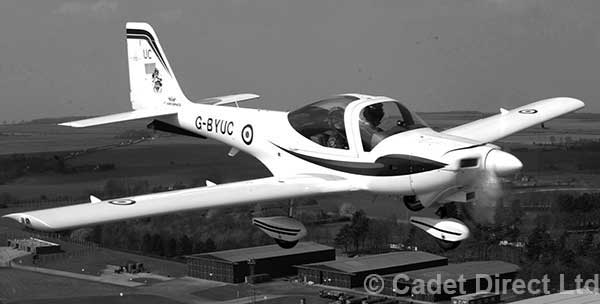 Tutor Grob 115E[/caption]
Tutor Grob 115E[/caption]
Tutor Grob 115E

